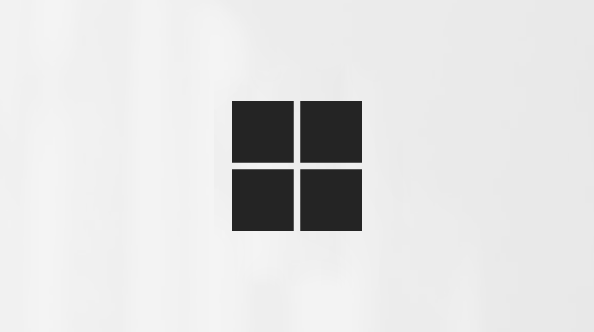This article is for people who use a screen reader program such as Windows Narrator, JAWS, or NVDA with Windows tools or features and Microsoft 365 products. This article is part of the Accessibility help & learning content set where you can find more accessibility information on our apps. For general help, visit Microsoft Support.
Use Project with your keyboard and a screen reader to review and edit both local and Project for the web projects. We have tested it with Narrator and JAWS, but it might work with other screen readers as long as they follow common accessibility standards and techniques.
Notes:
-
New Microsoft 365 features are released gradually to Microsoft 365 subscribers, so your app might not have these features yet. To learn how you can get new features faster, join the Office Insider program.
-
To learn more about screen readers, go to How screen readers work with Microsoft 365.
Open a recently used project
When you start Project, it opens a list of recently used projects and project templates.
-
Press the Tab key twice to move to the Recent projects list. You hear "Recent," followed by the name of the first project on the list.
-
Press the Down and Up arrow keys to move in the list of recent projects. When you hear the name of the project you want to open, press Enter.
Work with Project for the Web
It's easy to work on a shared project with your colleagues when you have access to Project for the web.
Create a Project for the Web account
-
Press Alt+F, I, and then press N to open the Project Web App Accounts dialog.
-
Press the Tab key until you hear “Add button,” and then press Spacebar. The Account Properties dialog opens.
-
You hear: "Account name, editing." With JAWS, you hear: "Account Properties." Type a name for the account, and then press the Tab key.
-
Type or paste the complete server URL. If you don't know the server URL, contact your server administrator.
Note: The URL must start with http:// or https:// and contain less than 129 characters. If you use the less secure http:// option, Project asks you to confirm the URL.
-
Press the Tab key until you hear "OK button," and then press Enter.
-
To confirm that you have the Choose an account mode selected, press Shift+Tab until you hear: "Selected, Choose an account." If you hear "Selected, Use my default account," press the Down arrow key once.
-
Press the Tab key until you hear "OK button," and then press Enter.
-
Press Esc to return to the main view of Project.
-
To start using the new account, close and restart Project. To learn how to sign in to the account, refer to Sign in to your Project for the Web account.
Sign in to your Project for the Web account
You only have to sign in to your Project for the web account once. Project remembers your credentials.
-
When you start Project after creating a Project for the web account, you hear: "Login, Profile, Computer." Press the Down arrow key until you hear the name of the online account.
-
Press the Tab key until you hear "OK button," and then press Enter.
-
When you use an online account for the first time, you hear: "Sign in." Type your email address.
-
Press the Tab key until you hear "Focus on Next button," and then press Enter.
-
You hear: "Sign in to your account, enter password." Type the password.
-
Press the Tab key until you hear "Sign in button," and then press Enter. When you hear "Blank Project button," you know that the sign-in process has finished.
Open a project from Project for the Web
After signing in once, you can open online projects as easily as if they were stored on your computer. To learn how to sign in to an online account, refer to Sign in to your Project for the Web account.
-
When you start Project, you hear: "Login, Profile, Computer." Press the Down arrow key until you hear the name of the online account you want to use.
-
Press the Tab key until you hear "OK button," and then press Enter.
-
Press the Tab key until you hear "Open other projects, hyperlink," and then press Enter. You hear: "Recent projects, list updated."
Tip: The above applies when you have just opened Project. To open an online project later, press Alt+F, O, Y, 1, and then continue from step 3.
-
Press the Tab key until you hear "Recent tab item," and then press the Up or Down arrow key until you hear "Project Web App," followed by the name of your test account.
-
Press the Tab key until you hear "Project Web App, off, Browse, button," and then press Enter. You hear: "Shell folder view, table, show me the list of all projects."
-
Press Spacebar, and then press Enter. You hear: "Shell folder view," followed by the name of the first project and the number of projects, for example, "1 of 10."
-
Use the Down and Up arrow keys to find the project you want to open, and then press Enter.
Note: Project may prompt you to select Yes or No when you open an online project. This means that the project you opened uses a different currency from the one specified by the server. If you want to overwrite the project currency with the server currency, select the Yes button, otherwise select No. Press the Tab key to move between the buttons, and then press Enter to confirm the selection.
Add a new column to the Gantt chart
Your project opens in the Gantt Chart view, which is the simplest view to work in. The focus is in the top left corner of the chart. In many projects, the default columns are not sufficient.
-
Press the Left and Right arrow keys to find the column that is to the right of the place where you want to add a column. Your screen reader announces what is written in the current cell, followed by the name of the column.
-
Press Alt+J, F, U to insert a new column to the left of the currently selected column. Press the Down and Up arrow keys to find the column name you want, and then press Enter to add it to the chart. With Narrator, you can type a partial name and then use the Down and Up arrow keys to browse the predefined column names that match. For example, if you type actual, Project suggests Actual Cost, Actual Duration, and so on.
Note: Instead of choosing a predefined column name, you can type your own. With JAWS, this is the option you should use, as JAWS doesn't announce the column name until after you have added it.
Add tasks to the Timeline
-
To move to the Timeline view, press Alt+H, G, and then press L.
-
Press Alt+J, F, and then press X. You hear: "Add Tasks to Timeline," followed by the project's name.
-
The focus is on the top-level task, which includes the whole project. To select which tasks you want to add to the Timeline, use the Down and Up arrow keys to move between the tasks, and press Spacebar to add the currently selected task.
-
When you have selected all the tasks you want, press Enter to close the Add Tasks to Timeline dialog. The Timeline is updated to match your selections.
Use summary tasks
You can indent tasks to show hierarchy, that is, to turn your task list into an outline of your project. An indented task becomes a subtask of the task above it, which becomes a summary task.
Tip: Avoid assigning resources to summary tasks. Assign them to the subtasks instead, or you might not be able to resolve overallocations.
-
To move to the Gantt Chart view, press Alt+H, G, and then press G.
-
Use the arrow keys to find the right task in the Task Name column. Your screen reader announces what is written in the current cell, followed by the name of the column.
-
Press Alt+Shift+Right arrow key to indent the current task, making it a subtask. This makes the task above it a summary task. With JAWS, you hear: "Level 2."
Note: With Narrator, you only hear "Expanded" or "Collapsed" when the focus is on a summary task. You can add the WBS column to the Gantt Chart view to make the task hierarchy clearer. The WBS column shows the row number of each task, and subtasks use different numbering. For example, if the summary task is number 7, its subtasks are 7.1, 7.2, and so on. To learn how to add a column, go to Add a new column to the Gantt chart.
-
To add another subtask to the summary task, press the Down arrow key to go to the next row in the Task Name column, then press Alt+Shift+Right arrow key.
-
If you need to return a subtask to a normal task, press Alt+Shift+Left arrow key. With JAWS, you hear "Level 1."
Tip: You can hide a subtask from view by pressing Alt+Shift+Minus sign (-) on the numeric keypad. You hear: "Subtract." To expand the summary task again, press Alt+Shift+Plus sign (+).
See also
Use a screen reader to create a new project in Project
Keyboard shortcuts for Project
Set up your device to work with accessibility in Microsoft 365
Use Project for the web with your keyboard and screen reader to edit your project by adding new tasks to the project timeline or columns to project grid. We have tested it with Narrator in Microsoft Edge, but it might work with other screen readers and web browsers as long as they follow common accessibility standards and techniques. You'll also learn how to create summary tasks and open recent projects.
Once you've opened a project in Project for the web, you can start editing the project details straight away. You don't need to check out a project to work on it. Your changes are saved and published automatically as you edit the project.
Notes:
-
New Microsoft 365 features are released gradually to Microsoft 365 subscribers, so your app might not have these features yet. To learn how you can get new features faster, join the Office Insider program.
-
To learn more about screen readers, go to How screen readers work with Microsoft 365.
-
When you use Project for the web, we recommend that you use Microsoft Edge as your web browser. Because Project for the web runs in your web browser, the keyboard shortcuts are different from those in the desktop program. For example, you’ll use Ctrl+F6 instead of F6 for jumping in and out of the commands. Also, common shortcuts like F1 (Help) and Ctrl+O (Open) apply to the web browser – not Project for the web.
Open a recent project
You can quickly open and edit a project that you've recently been working on.
-
In Project Home, press the Tab key or Shift+Tab until you hear the currently selected tab, followed by "Tab item."
-
Press the Left or Right arrow key until you hear "Recent, tab item, and then press Enter.
-
To move the focus to the list of your recent items, press the Tab key or Shift+Tab. You hear the name of the currently selected project or roadmap.
-
Press the Down arrow key until you hear the project you want, and then press Enter to open it. The project opens in the Grid view. For instructions on how to use the Grid view, refer to Use a screen reader to work with the grid view in Project.
Add a new column to a project in the Grid view
You can add columns to the project grid to add and show additional info.
-
In the Grid view, press Ctrl+F6 until you hear: "Grid view, region landmark."
-
Press the Right arrow key until you hear "Open menu, Add column," and then press Enter.
-
Press the Down arrow key until you hear the type of the new column you want to add and then press Enter to add it.
Add a new task to the project timeline
In the Timeline view, you can add a task either between two existing tasks or as the last item to the bottom of the task list.
For instructions on how to use the Timeline view, refer to Use a screen reader to work with the timeline view in Project.
Add a new task between two tasks
-
In the Timeline view, press Ctrl+F6 until you hear: "Side grid."
-
Press the Tab key until you find the task above which you want to add the new task.
-
To open the task menu, press Alt+M.
-
Press the Down arrow key until you hear "Insert task above," and then press Enter.
-
You hear: "Edit, Untitled task." Type the name of the new task, and then press Enter to add the task to the project timeline. For instructions on how to edit task details, refer to Use a screen reader to view and edit task details in Project.
Add a task to the bottom of the task list
-
In the Timeline view, press Ctrl+F6 until you hear: "Side grid."
-
Press the Tab key until you hear: "Add new task, Name."
-
Type the name of the new task. and then press Enter to add the task to the project timeline. For instructions on how to edit task details, refer to Use a screen reader to view and edit task details in Project.
Use summary tasks
You can indent tasks to show hierarchy, that is, to turn your task list into an outline of your project. An indented task becomes a subtask of the task above it, which becomes a summary task.
-
In the Grid or Timeline view, navigate to the task you want to make into a subtask of the preceding task.
-
To open the task menu, press Alt+M.
-
Press the Down arrow key until you hear "Make subtask," and then press Enter to indent the task.
See also
Use a screen reader to create a new project in Project
Use a screen reader to build a team in Project
Keyboard shortcuts for Project
Use Project Online with your keyboard and a screen reader to review or edit a project. We have tested it with Narrator, but it might work with other screen readers as long as they follow common accessibility standards and techniques.
Notes:
-
New Microsoft 365 features are released gradually to Microsoft 365 subscribers, so your app might not have these features yet. To learn how you can get new features faster, join the Office Insider program.
-
To learn more about screen readers, go to How screen readers work with Microsoft 365.
-
When you use Project Online, we recommend that you use Microsoft Edge as your web browser. Because Project Online runs in your web browser, the keyboard shortcuts are different from those in the desktop program. For example, you’ll use Ctrl+F6 instead of F6 for jumping in and out of the commands. Also, common shortcuts like F1 (Help) and Ctrl+O (Open) apply to the web browser – not Project Online.
Check out a project
In the Project view, press the Tab key until you hear “Edit button,” and press Enter.
Read and edit project details
-
In the Project view, press the Tab key until you hear “Project details,” and press Enter.
-
Press the Tab key until you hear “Project tab,” and press Enter.
-
Press the Tab key until you hear “Edit button,” and press Enter.
-
Press the Tab key to cycle through the project detail fields and edit them using the keyboard.
-
To change the project start date, press the Tab key until you hear “Select a date from the calendar button,” and press Enter. The calendar popup opens. Select a date with the Left and Right arrow keys and press Enter.
-
To save your changes, press the Tab key until you hear “Save button,” and press Enter.
-
Press the Tab key until you hear “Close button,” and press Enter.
-
The Close dialog opens, asking if you want to check in the project. Do one of the following:
-
To check in the project, press Enter.
-
To keep the project checked out, press Ctrl+Tab. You hear: “Do you want to check your project in? Selected, check it in.” Press R to move to the next option. You hear: “Not selected, keep it checked out.” Press Enter to select the option, press the Tab key to highlight the OK button, and then press Enter to close the dialog.
-
Add tasks to a timeline
-
In the Project view, press the Tab key until you hear “Task schedule tools group,” and press Enter.
-
Press the Tab key until you hear: “Table.” You can navigate the table rows by pressing Ctrl+Alt+Up or Down arrow keys, and the table columns by pressing Ctrl+Alt+Left or Right arrow keys. When you have found the task you want to add to the timeline, press Enter to select it.
-
Press Ctrl+F6 to leave the table.
-
Press the Tab key until you hear “Add to timeline button,” and press Enter to add the task to the timeline.
Use summary tasks
You can indent tasks to show hierarchy, that is, to turn your task list into an outline of your project. An indented task becomes a subtask of the task above it, which becomes a summary task.
-
In the Project view, press the Tab key until you hear “Task schedule tools group,” and press Enter.
-
Press the Tab key until you hear: “Table.” You can navigate the table rows by pressing Ctrl+Alt+Up or Down arrow keys, and the table columns by pressing Ctrl+Alt+Left or Right arrow keys. When you have found the task you want to indent, press Enter to select it.
-
Press Ctrl+F6 to leave the table.
-
Press the Tab key until you hear “Indent button,” and press Enter to indent the task.
Save and publish changes, and check in
Save changes in a project
In the Project view, press the Tab key until you hear “Save button,” and press Enter.
Publish the project schedule
-
In the Project view, press the Tab key until you hear “Task schedule tools group,” and press Enter.
-
Press the Tab key until you hear “Publish button,” and press Enter.
Close and check in a project
-
In the Project view, press the Tab key until you hear “Close button,” and then press Enter.
-
The Close dialog opens, asking if you want to check in the project. Press Enter to check in the project.
See also
Use a screen reader to create a new project in Project
Use a screen reader to build a team in Project
Technical support for customers with disabilities
Microsoft wants to provide the best possible experience for all our customers. If you have a disability or questions related to accessibility, please contact the Microsoft Disability Answer Desk for technical assistance. The Disability Answer Desk support team is trained in using many popular assistive technologies and can offer assistance in English, Spanish, French, and American Sign Language. Please go to the Microsoft Disability Answer Desk site to find out the contact details for your region.
If you are a government, commercial, or enterprise user, please contact the enterprise Disability Answer Desk.











